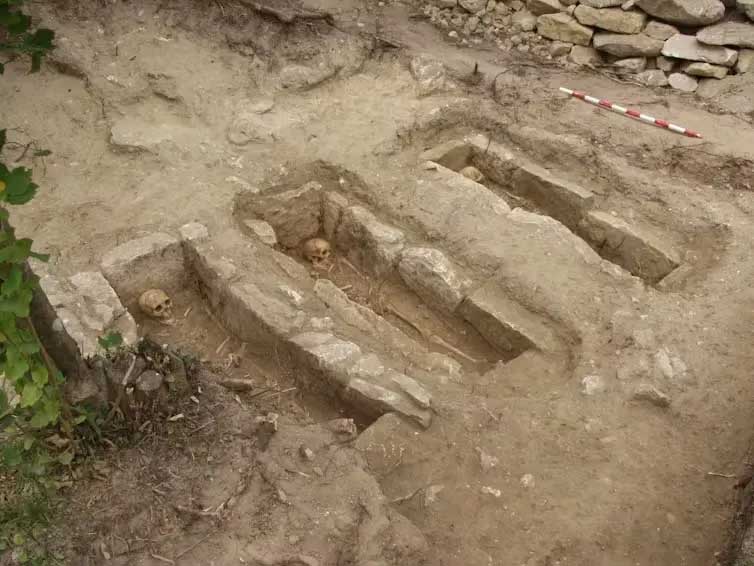LiDAR technology in Ireland reveals hidden structures that could guide spirits into the afterlife. A child’s burial site from the 4th millennium BC was found in Armenia.
A child’s burial site dating back to the 4th millennium BC has been found in Armenia. This means that the burial either dates back to the same time period or to an earlier period, said archaeologist Pavel Avetisyan
An Armenian-American expedition of archaeologists discovered a child’s burial in the Neolithic settlement of Masis Blur, which dates back to the 4th millennium BC. This was written on his Facebook page by archaeologist Professor Pavel Avetisyan.

Sergei Malgavko/TASS
“Seven days have passed since the Armenian-American expedition began excavations of the Neolithic settlement of Masis Blur. There is already an exceptional result. A child’s grave was found under the wall of the building. The building is located in a layer of the first quarter of the 4th millennium BC. This means that the burial either dates back to the same time or to an earlier period,” the scientist noted.
According to Avetisyan, there are two burials in Armenia that clearly date to this period and have a clear context: one in the Aknashen settlement and the other in Masis Blur. “DNA analysis of this new burial will help to complete our understanding of the Neolithic societies that lived north of the Araks River. Right now, as I write these lines, my colleagues are continuing to work on cleaning the child’s skeleton. This is an extremely important find,” he added.
Archaeologists have discovered ancient monuments that may be paths for the dead. Using LiDAR technology, archaeologists have discovered a group of five rare Neolithic earthen monuments in Ireland. The ancient finds show evidence of ritual practices likely related to solar events and ceremonial paths for the dead.
Researchers hope the discovery, now believed to be one of the largest archaeological sites in the country, will help change understanding of Ireland’s prehistoric culture.
A group of five large earthen monuments have been lying together in the Irish town of Baltinglass since Neolithic times. But scientists have only recently discovered them thanks to LiDAR technology. Considered to be among the largest archaeological sites ever found in Ireland, these rare ‘cursus’ structures played a key role in ancient life, providing ritual and ceremonial significance for early farming communities and potentially even forming ‘route of the dead’ leading to the afterlife.
The discovery was made by James O’Driscoll of the University of Aberdeen, who spent more than a decade studying the Baltinglass landscape – an area known for Bronze Age and medieval forts, but not for Neolithic cursus. Using laser mapping with light detection and ranging (LiDAR), O’Driscoll was able to identify the largest concentration of cursus in both Ireland and Britain. The results were published in the journal Antiquity.
The cursus, described in O’Driscoll’s study as a paved space marked by segmented mounds, ditches and palisades, “became a means of bringing disparate communities together for ritual and the creation of a unified group identity.”
These enclosures have been found clustered together in southern England, France and Scandinavia, but the Baltinglass find singles out a group of five cursus monuments. It offers a unique insight into Neolithic Ireland.

Kavan Images
The largest structure is 1,312 feet long, while other similar structures are typically between 500 and 650 feet long. The discovery of the cursus monuments is particularly significant as they are incredibly rare in Ireland.
The researchers believe the new discovery, when placed in the context of the landscape, could be linked to important solar events such as the summer solstice sunrise, which would have been key for a relatively early farming community. But that’s not all.
The function of these types of monuments has always been a sensitive topic, as researchers have little information. But given that some of the Baltinglass monuments can also be associated with funerary monuments, it suggests that they may have been ceremonial monuments used in burial rites, with the cursus marking the physical path by which the dead passed from the world of the living to the afterlife.
The discovery of such prominent cursuses grouped together led O’Driscoll to believe they indicated Baltinglass was a key farming community during the Neolithic period (c. 4000 to 2000 BC). And given evidence showing activity in the early Neolithic and mid-late Bronze Ages, O’Driscoll said the new research could challenge the idea that the area was abandoned in the two millennia between the eras.
O’Driscoll also believes that wooden spades were likely a key tool in the construction, which shows how much resources, time and effort went into their construction, as this was a significant settlement.
Future research, including soil analysis of the area, will attempt to better understand agricultural practices during the Early Neolithic period.






